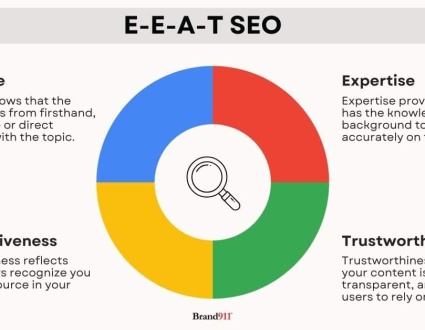
Search Engine Optimization (SEO) is how people find you online. Done right, it brings consistent, free traffic to your website from search engines like Google. You don’t need to be a developer to get started, just a clear process.
This guide breaks down how to prepare your site, master the basics, and avoid common mistakes so you can start improving your search visibility today.
What is SEO?
SEO is the process of making your website easier to discover in search results. When someone searches for products, services, or answers, search engines rank billions of pages and display the most relevant ones.
Good SEO makes sure your site is one of those results. It’s about:
- Matching the words your audience searches
- Structuring your site so Google understands it
- Building trust through content and links
- Tracking what’s working and improving over time
How Search Engines Work
Search engines like Google organize the internet so people can quickly find what they’re looking for. The process happens in three main stages:
- Crawl: Automated programs (often called “spiders” or “bots”) move across the web, following links from one page to another. They scan your site to discover new pages and updates. If your site isn’t linked properly or blocks crawlers, Google may never see parts of it.
- Index: Once discovered, your pages are stored in Google’s database. Here, search engines analyze the text, headings, images, and technical elements to understand what each page is about. A clear site structure and use of keywords help Google file your content under the right topics.
- Rank: When someone searches, algorithms instantly sort through billions of indexed pages to decide which results are most helpful. They look at many factors—content relevance, backlinks, page speed, mobile experience, and overall authority—to determine your position in the results.
Your job is to:
- Make your site easy to crawl with good internal links and a sitemap.
- Keep your content clear and structured so it’s indexed correctly.
- Build trust and authority with quality content and links so your pages rank higher.
SEO is simply aligning your website with this process so Google can understand it and recommend it to searchers.

How to Prepare Your Website for SEO Success
Before you jump into tactics, set up a solid foundation:
- Get a good domain: Ideally short, memorable, and relevant to your brand.
- Choose the right platform: Hosted builders like Squarespace/Wix or self-hosted WordPress both work—pick what you can maintain.
- Use reliable hosting: Speed and uptime matter. A strong host keeps your site available and fast.
- Create a good user experience: Use HTTPS with an SSL certificate. Keep design clean and mobile-friendly. Use readable fonts and accessible color contrast
- Avoid clutter: Minimize intrusive pop-ups and keep load times fast.
- Build logical site structure: Plan categories and menus so users and bots can find content easily.
- Set clear URLs: Keep them short, descriptive, and keyword-friendly.
- Install an SEO plugin: Tools like Yoast or Rank Math help manage metadata, sitemaps, and on-page settings.
- Local businesses: Focus on local SEO for small businesses to capture nearby searches.
- Sitemap: Generate one in your CMS or plugin and submit it in Google Search Console.
SEO Basics: 5 Steps to Get Started
Step 1: Keyword Research
Keywords connect your content to search intent.
How to start:
- Brainstorm seed topics your audience cares about.
- Use free tools like Google Autocomplete, “People Also Ask,” and Google Trends to expand your list.
- Check search volume and competition with free tools like Ubersuggest.
- Target long-tail keywords (specific phrases like “best plumber in Boston” instead of “plumber”).
Quick win: Use Google Search Console to see queries you already appear for. Improve those pages with clearer titles and better answers.
See our guide on writing SEO-friendly blog posts to learn how to optimize for your chosen terms.
Step 2: On-Page SEO
On-page SEO tells search engines—and readers—what each page is about.
Essentials:
- Title tag: 50–60 characters. Place your keyword first.
- Meta description: 150–160 characters. Persuasive and clear.
- Headings (H1, H2, H3): Organize content logically.
- URL: Short and descriptive. Example: /emergency-plumber-boston.
- Images: Compress and add descriptive alt text.
- Internal links: Link to related content with descriptive anchors (see how to increase blog traffic).
Step 3: Technical Basics
Search engines value fast, secure, mobile-friendly sites.
Checklist:
- Run PageSpeed Insights and fix large files slowing your site.
- Use responsive design for mobile.
- Ensure HTTPS with an SSL certificate.
- Submit your XML sitemap in Search Console.
- Keep navigation simple: homepage → categories → posts/services.
Learn more in our guide to voice search optimization—speed and mobile design are key there too.
Step 4: Links
Links from other sites act as trust signals that your content is reliable and worth ranking.
Focus on quality:
- Publish helpful resources others will reference (guides, data, checklists).
- Guest post or share insights on niche blogs and podcasts.
- Use HARO or similar platforms to get quoted by journalists.
- Get listed in credible local directories.
Quick win: Add internal links from your top-traffic pages to new ones. This spreads authority across your site.
For a deeper dive, check out our guide on how to build backlinks for strategies that go beyond the basics.
Step 5: Track Results
SEO works best when you measure progress regularly and adjust as needed.
Tools to use:
- Google Analytics 4 (GA4): Track organic traffic and see if visitors are converting (calls, forms, sales).
- Google Search Console (GSC): Monitor which keywords bring traffic, your rankings, CTR, and indexing issues.
Check monthly:
- Organic traffic growth – Is it trending upward?
- CTR – Are people clicking your results?
- Conversions – Are search visitors taking action?
Consistent SEO builds momentum over time, turning small improvements into lasting growth. Learn more about building long-term trust in our reputation marketing guide.

Rookie Mistakes to Avoid
Even with the basics in place, common errors can hold back your SEO. Here are a few to steer clear of:
| Bad Practice | Good Practice Instead |
| Keyword stuffing – Forcing the same keyword into every sentence. | Write naturally. Use variations, synonyms, and related terms to keep content readable. |
| Buying or exchanging links – Paying for backlinks or trading them in bulk. | Earn links by publishing helpful content, building relationships, and doing outreach. |
| Duplicate or thin content – Copying text or publishing very short pages. | Create original, in-depth content that answers questions fully. |
| Using meta keyword tags – Obsolete tag Google no longer uses. | Focus on titles, headings, meta descriptions, and well-structured content. |
| Over-optimizing anchor text – Using the same exact keyword in every internal/external link. | Mix anchor text with descriptive phrases, partial matches, and branded terms. |
| Redesigning without redirects – Changing URLs and losing authority from old pages. | Set up 301 redirects so old URLs pass authority to the new ones. |
Final Thoughts
Basic SEO isn’t complicated. Start with keywords, optimize your pages, fix technical issues, earn trusted links, and track results.
You don’t need to do everything at once. Improve one page today and build from there. Each step adds up, helping your site get found by the people already searching for what you offer.
Want expert guidance as you grow? Explore our SEO services to see how Brand911 can help you strengthen your visibility and build long-term search success.
FAQ
How long does SEO take to work?
SEO is a long game. Most sites start seeing measurable improvements in 3–6 months, especially if you consistently publish optimized content and earn links. New websites usually take longer because they don’t yet have authority. Established sites can see results faster since they already have traffic and backlinks. Think of SEO as building momentum over time rather than expecting overnight wins.
Do I need coding skills?
No. Most essential SEO tasks—like writing optimized content, improving titles, or adding internal links—require zero coding. Platforms like WordPress, Wix, and Squarespace handle technical elements for you. Plugins such as Yoast or Rank Math make it even easier to update metadata and generate sitemaps. Coding only comes into play for advanced fixes, like custom schema or site migrations.
What metric should I track first?
Start with organic traffic in Google Analytics. This tells you how many people are finding your site through search. As you grow more confident, add keyword rankings from Google Search Console, click-through rates (CTR) on your titles, and conversion metrics like form fills or sales. The most important thing is to track progress monthly, not daily, so you can see real trends.
What’s the difference between SEO and paid ads?
SEO focuses on building long-term visibility in search results. It compounds over time and continues working even if you pause efforts. Paid ads, on the other hand, deliver immediate visibility but stop the moment you stop paying. Many businesses use both, but SEO provides a stronger foundation for sustainable growth.
Can small businesses compete with bigger brands?
Yes. The key is targeting specific niches or local keywords. Instead of going after broad, high-competition terms like “insurance,” focus on location-based or service-specific keywords like “life insurance agent in Boston.” Local SEO levels the playing field and helps smaller businesses show up where it matters most.
Should I focus on Google only?
Yes, for most cases. Google handles over 90% of global searches, making it the primary search engine to optimize for. Other platforms like Bing or DuckDuckGo can bring some traffic, but the fundamentals are the same—good content, fast websites, and useful information.
Do blog posts really help with SEO?
Absolutely. Consistently publishing well-optimized blog posts gives search engines more content to index and more opportunities to match user queries. A single SEO-friendly blog post can rank for dozens of keywords and drive traffic for years. Blogs also help build internal links and establish authority in your niche.
About us and this blog
We are a digital marketing company with a focus on helping our customers achieve great results across several key areas.
Request a free quote
We offer professional SEO services that help websites increase their organic search score drastically in order to compete for the highest rankings even when it comes to highly competitive keywords.
Subscribe to our newsletter!
More from our blog
See all postsRecent Posts
- How to Distribute a Press Release (Without Wasting Time or Money) December 23, 2025
- What Is SEO Content? A Comprehensive Guide December 18, 2025
- How to Rebrand Yourself: A Practical 5-Step Plan for Professionals December 16, 2025













Recent Comments